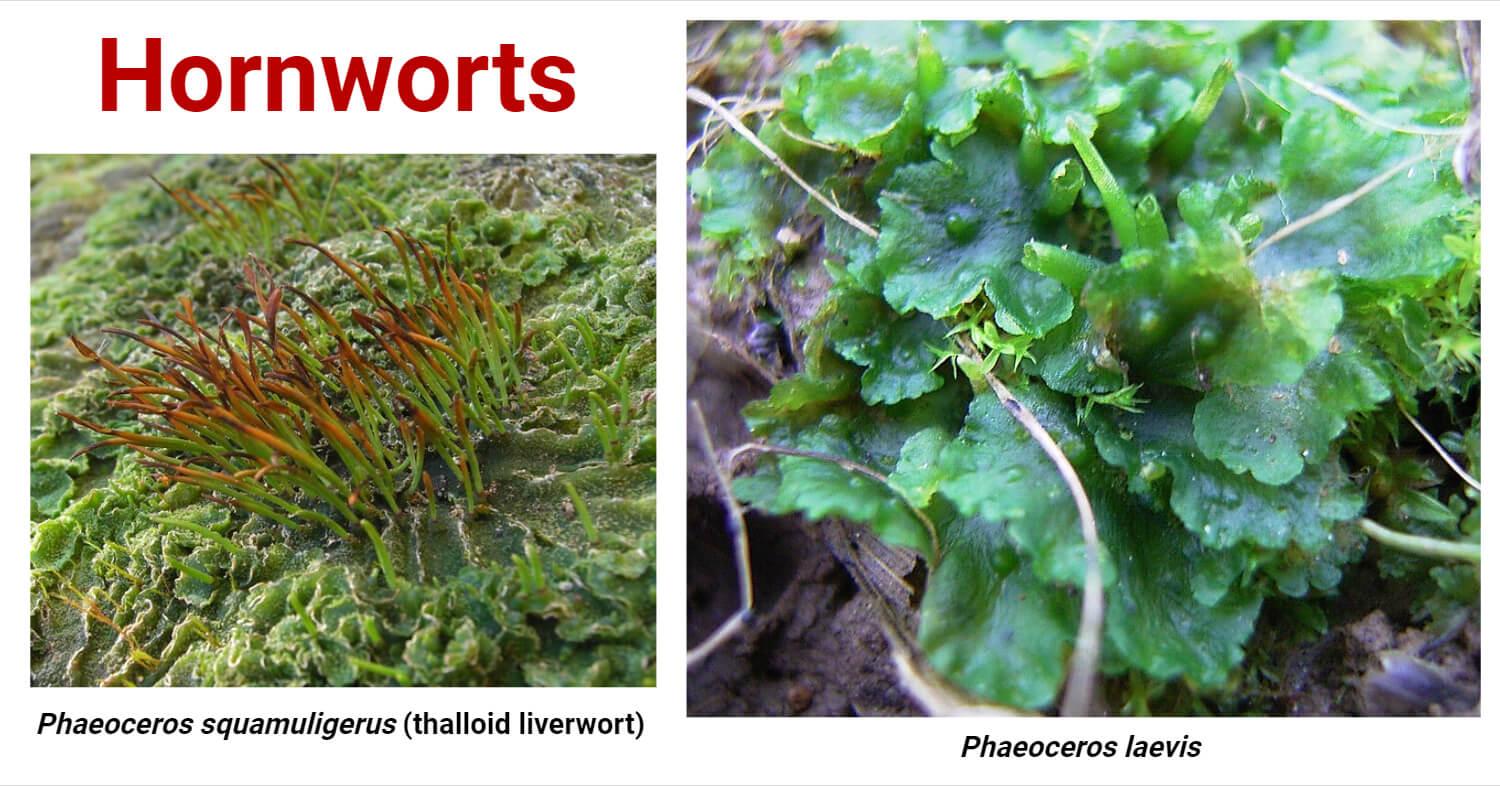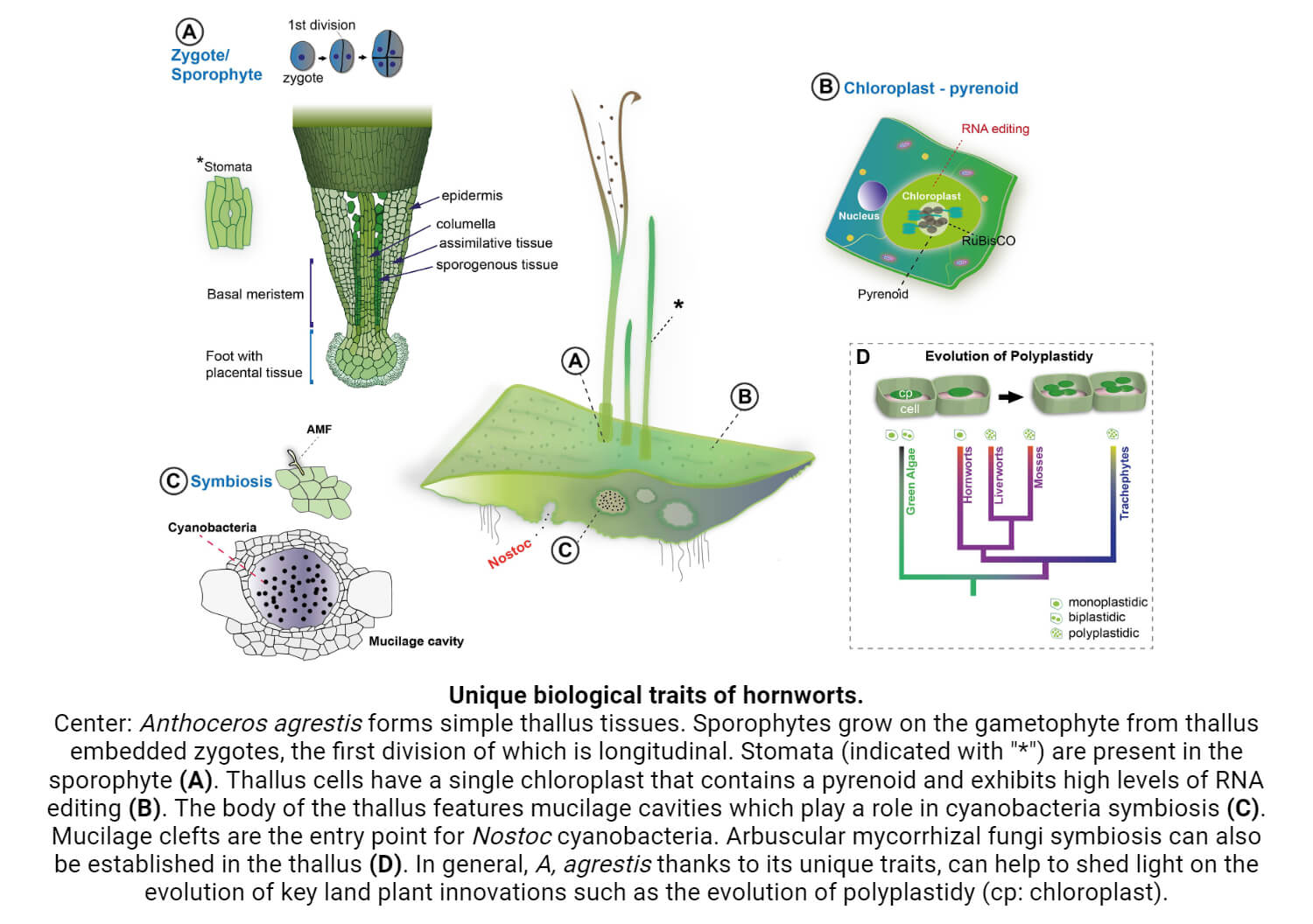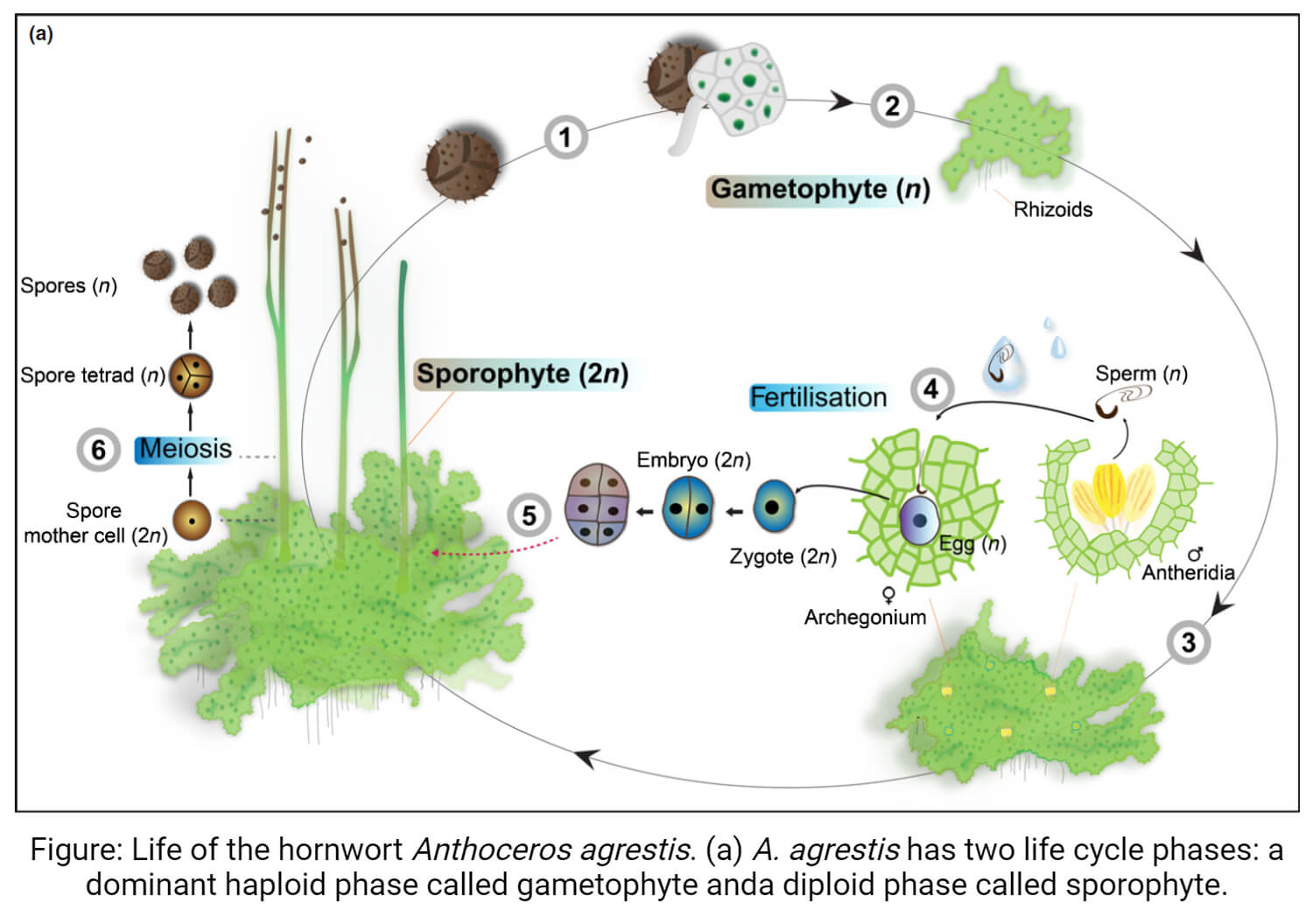The class Anthocerotopsida embraces a small group of bryophytes and most popularly they are known as hornworts. They are called as “hornworts” because the sporophytes are elongated cylindrical structure that resembles horns.
Interesting Science Videos
Habitat and Distribution of Hornworts
Hornworts prefer to grow in moist, shady places. They prefer to grow in such places where there is abundant moisture as water is essential for the reproductive purposes. They are mostly found in Tropical and warm Temperate regions.
Some species also grows on the bark of trees (epiphytic), damp soils (terrestrial), rocks (lithophytic) etc. About 300 species of hornworts has been reported.

Morphology of Hornworts
The plant body (gametophyte) is a having lobed thallus, simple in form without dichotomus branching. The thallus is either with or without a midrib. The thallus is attached to the substratum by simple, unicellular smooth-walled rhizoids. Tuberculate rhizoids and ventral scales are absent. Their sex organs (antheridia and archegonia) are embedded inside the thallus. As liverworts, they lack vascular system. The sporophytes are elongated structures that are attached to the gametophytic thallus.
Salient Features of Hornworts
- The adult plant is an independent gametophyte which is thalloid that are dorsiventrally flattened.
- All hornworts have symbiotic relationship with cyanobacteria that resides inside their body cavity.
- The thallus is attached to the substratum by means of smooth-walled rhizoids, tuberculate rhizoids and ventral scales are absent.
- Internally, thallus is not differentiated into different zones but has a uniform cellular organization.
- Thallus may be monoecious or dioecious in which sex organs are sunken inside the tallus.
- The antheridia and archegonia develop in the dorsal surface of the thallus.
- Sporophyte is differentiated into foot, intercalary meristematic zone and capsule.
- Sporophyte is partially independent or dependent upon the gametophyte.

Classification of Hornworts
Stotler R.E. and B.Crandall Stotler (2005) proposed the following classification:
Division Anthocerophyta – Under this, there are two classes:
- Leiosporocerotopsioda– Under this class, there is only one order- Leiosporocerotales.
- Anthocerotopsida– Under this class, there are two orders- Anthocerotales and Notothyladales.
Reproduction in Hornworts
Asexual Reproduction
Hornworts reproduce asexually by various means:
- Fragmentation: The cells in the basal portion of thallus die and disorganize and when the progressive decay reaches the branching region, the thallus lobes becomes separated. Each separated lobes give rise to new individual. Example includes some species of Anthoceros.
- Gemmae: Some bryologists reported the formation of gemmae on short stalks and along the margin of thallus in A.glandulosus, A.formosae and others. This gemma detaches and gives rise to new thallus.
- Tubers: Certain species of Anthoceros which are exposed to drought develops marginal thickenings called tubers. With the onset of favourable condition, these tubers give rise to new individual. Tuber formation has been reported in species such as A.himalayensis, A. tuberosus, etc.
- Persistent growing apices: During unfavourable season, all the plant dries up excluding some cells on the growing point of thallus lobes. These are known as persistent apices which resumes growth with the return of favourable condition. This type of reproduction is seen in A. pearsoni and A. fusiformis.
- Apospory: The phenomenon of production of gametophyte thallus directly from vegetative cells of the sporogonium is called apospory. Some species of Anthoceros may show this type of reproduction.
Sexual Reproduction
Sexual reproduction takes place by formation of antheridium and archegonium.
Some species are monoecious whereas some are dioecious. According to Bell and Woodock (1968), the depelopment of sex organs in some genus like Anthoceros under this class depends upon photoperiod.
Antheridia
They occurs singly or in groups on the upper surface of thallus. Each antheridium has an ovoid pouch like body raised on multicellular long slender stalk. The body of antheridia consists of a jacket layer or antheridial wall that includes mass of androcytes which later on maturity forms male gametes. When antheridia reach maturity, the sperms dehisce in water. Sperms are biflagellate.
Archegonia
Archegonia is sunk deeply in the thallus of upper surface. Each archegonium consists of neck canal cells, a ventral canal cells and egg. There is no sterile jacket except the rosette cells present at the distal end which are commonly known as cover cells.
Fertilization in Hornworts
At maturity, the neck canal cells are removed and filled with mucilage which acts as an open passage for sperms. The biflagellate sperm swim down the canal and fuses with egg to form zygote and then sporophyte generation begins.
Sporophytic phase
The zygote is the pioneer structure of this phase. By repeated segmentation, it develops into an elongated embryo. The embryo later by cell division, cell differentiation, grows into elongated horn like structure called the sporogonium or sporophyte.
Sporogonium is differentiated into three regions- foot, intercalary meristematic zone and capsule. At the base of the foot, there is an involucre which is an outgrowth from gametophytic thallus. It is protective in function and gives support to intercalary zone.
Capsule is the major part of sporophyte which is long, slender, smooth, upright and cylindrical. It is almost uniform in thickness throughout the length. Usually they are light green in colour and turn brown towards maturity. The maturation of spores is from the apex to downwards.
Foot is the rounded bulbous structure embedded in the tissue of thallus. The main function of foot is anchorage. Foot also acts as haustorium that absorbs food and water from the parent thallus for the sporophyte. The region of contact between foot and thallus tissue is called placenta.
Intermediate or intercalary zone is a narrow zone of meristematic cells located at the base of capsule above the foot. It constantly adds new cells to capsule at the base.
The sporophyte in anthocerotopsida is semi-independent. They have photosynthetic tissue in the capsule wall. They depend on gametophyte for water and minerals.
Development of sporophyte
The fertilized egg enlarges until it fills the venter cavity. After this, zygote repeatedly divides to form octant stage where two tiers of four cells are seen. Out of this, the upper tier forms the capsule and intermediate zone and the lower tier forms the foot. The capsule cells differentiate into pseudo elaters mother cells and spore mother cells. Pseudo elater mother cells give rise to pseudo elater. Spore mother cell undergoes meiosis to form four haploid nuclei and the cell walls are laid simultaneously to form four tetrahedral spore. Usually spores are yellow in colour in some species and black in colour in others.
The spore dehiscence takes place by rupture of capsule wall and carried by winds. These spores then germinate and produce gametophyte generation.

Alternation of Generation in Hornworts
Gametophyte (haplophase): Haplophase starts with the formation of spores. These spores undergo germination to form green fleshy gametophyte. The gametophyte bearing sex organs- antheridia and archegonia produces sperms and egg respectively which give rise to zygote.
Sporophyte (diplophase): The diplophase starts with fertilized egg or zygote. It has diploid number of chromosomes. The zygote undergoes cell division and differentiation to produce sporogonium. It is also known as sporophyte as it produces meiospores.
Economic Importance of Hornworts
The economic importance of hornworts are as follows:
Soil Formation and Stabilization: Hornworts contribute to soil formation by breaking down rocks and also helps in preventing soil erosion.
Nutrient Cycling: They play a significant role in nutrient cycling in ecosystems. By decomposing organic matter, they release nutrients back into the soil, making them available for other plants.
Bioindicators: Hornworts are sensitive to environmental changes and pollutants, making them useful bio indicators for monitoring the health of ecosystems and detecting pollution.
Phytochemicals and medicines: Hornworts contain unique bioactive compounds that have potential medicinal properties. Some species of Anthoceros are used for medicinal purposes.
Genetic Research: Due to their simple structure and lifecycle, hornworts are used in genetic research to understand plant development and evolution.
Bioremediation: Hornworts have the potential to remove or neutralize contaminants in the soil and water which is known as bioremediation. They are also used in aquarium for decorative purposes as well as bioremediation.
References
- Barlett. E.H. 1928. A comparative study of the development of the sporophyte of Anthocerotaceae with special reference to the genus Anthoceros. Ann. Bot. 42: 409-430.
- Bryophyte by B.R. Vashishta, A.K. Sinha, Adarsh Kumar (S.Chand & Company ltd)
- Class anthocerotopsida. (n.d.). iNaturalist United Kingdom. https://uk.inaturalist.org/taxa/56328-Anthocerotopsida
- Lang, W.H. 1901. On apospory in Anthoceros laevis. Ann. Bot., 15 : 503-510.
- Proskaeur, J, 1948. Studies on the morphology of Anthoceros. I. Ann. Bot. (Lond) N.S. 12: 237-265.
- Proskaeur, J. 1948. Studies on the morphology of Anthoceros. II. Ann.Bot. (Lond.) N.S. 12: 427-440.
- Proskaeur, J. 1951. Studies on the Anthocerotales. III. Bull: Torrey Bot. Club.78: 331-349.
- Proskaeur, J. 1953. Studies on the Anthocerotales. IV. Bull: Torrey Bot. Club.80: 65-75.
- Proskaeur, J. 1957. Studies on the Anthocerotales. V. Phytomorphology, 7: 113-135.
- Smith, G.M. 1955. Cryptogamic Botany. Vol. II. Bryophytes and Pteridophytes. Edi.2, New York.
- Stotler, R.E. and B. Crand- Stotler. 2005. A revised classification of the Anthocerphyta and a checklist of the hornworts of North America, north of Mexico Bryologist, 108 16-26.
- Eric, R. (2021, July 14). Bryophytes (Mosses, liverworts, and Hornworts). Earth.com. https://www.earth.com/plant-encyclopedia/bryophytes/
- Zainabtahir. (2022, July 22). PPT – Economic importance of anthoceros PowerPoint Presentation, free download – ID:11487288. SlideServe. https://www.slideserve.com/zainabtahir123/economic-importance-of-anthoceros
